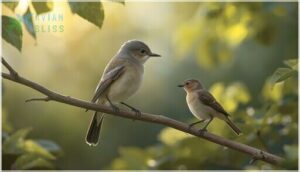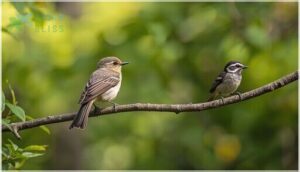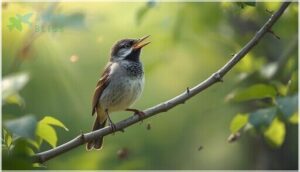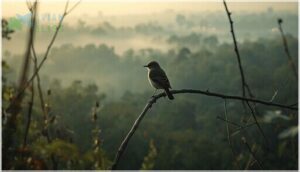This site is supported by our readers. We may earn a commission, at no cost to you, if you purchase through links.

Look longer, and its slender shape, flickering tail, and sudden dashes after insects tell the whole story of a bird made for the spaces in between. If you’ve ever wondered how these birds fit into a changing forest, their habits and struggles reveal far more than meets the eye.
Table Of Contents
- Key Takeaways
- Eastern Wood-Pewee Identification Guide
- Habitat and Geographic Range
- Behavior and Vocalizations
- Diet and Feeding Habits
- Conservation Status and Population Trends
- Frequently Asked Questions (FAQs)
- Do Eastern Wood-Pewee migrate?
- What is the difference between Eastern phoebe and Eastern Wood-Pewee?
- Where do Eastern Wood-Pewee nest?
- What bird makes a pewee sound?
- How long do eastern wood pewees live?
- What are the common predators of pewees?
- How do pewees handle long migrations?
- Do pewees change appearance with seasons?
- How can pewees be attracted to backyards?
- What is the lifespan of an Eastern Wood-Pewee?
- Conclusion
Key Takeaways
- Eastern Wood-Pewees are small woodland birds known for their upright posture, soft olive coloring, and sharp “pee-a-wee” call, making them easier to identify by sound than by sight.
- Their populations have dropped by about 70% since 1970, mainly due to habitat loss, fragmentation, and changes driven by climate and human activity.
- Each year, they migrate at night from North American forests to wintering grounds in South America, facing threats like deforestation and food shortages along the way.
- These birds play a key role in controlling insect populations and rely on open woodlands, native plants, and minimal human disturbance to thrive.
Eastern Wood-Pewee Identification Guide
Spotting an Eastern Wood-Pewee takes a sharp eye for detail. Let’s walk through what to look for, step by step. Here’s how you can tell this flycatcher apart from the crowd.
Size and Shape Compared to Similar Birds
When you spot an Eastern Wood-Pewee, their size and shape stand out among similar species. For example:
- Longer wing length and a slim, upright posture set them apart from Empidonax flycatchers.
- The tail shape is slightly notched, paired with a pointed bill size.
- Their body mass falls between chickadees and Eastern Bluebirds, making identification easier through careful comparison.
The species thrives in Minnesota’s wooded areas, where they breed and forage.
Plumage Coloration and Markings
Adult plumage on the Eastern Wood-Pewee carries a gentle olive-grey on the back, fading to whitish underparts. Juvenile plumage, in contrast, appears more buffy and muted, showcasing brighter wingbars and field marks. Subtle seasonal variation and molting patterns mean their color pattern changes slightly through the year—a key feature when making species comparisons.
As a summer resident, the pewee’s presence is important for controlling insect populations.
| Feature | Description |
|---|---|
| Adult Plumage | Olive-grey, whitish belly |
| Juvenile Plumage | Muted, buffy, bright wingbars |
| Color Pattern | Olive-green back, pale below |
| Molting Patterns | Seasonal fading, fresh colors |
| Species Comparison | Paler, distinct field marks |
Distinctive Wing-bars and Eye-ring Features
When you look up at an Eastern Wood-Pewee, pay close attention to those wingbars—both stripe across the wings in crisp, pale lines, locking in that Wing-bar Brightness every field guide talks about. Eyering? Nearly absent, setting this bird apart.
Juvenile markings often appear brighter and buffier, making Field Identification easier. Consistent shape and size round out these Avian Morphology features.
Key Traits Distinguishing From Empidonax Flycatchers
Next to those subtle wing-bars and nearly absent eyerings, focus on Bill Morphology and Tail Posture for WoodPewee identification. Compared with Empidonax flycatchers, Eastern Wood-Pewees show longer wings, square-tipped tails, and rarely wag them.
Listen for distinct Vocal Differences—“pee-a-wee” versus sharp “whit” calls. Eastern WoodPewee identification truly comes alive in these simple points of comparison with similar bird species.
Habitat and Geographic Range
To understand the Eastern Wood-Pewee’s world, it’s helpful to look at where these birds live and travel. Their story stretches from summer forests in North America to distant winter homes far to the south.
Here’s what you’ll want to know about their favorite environments and the paths they follow each year.
Preferred Forest and Woodland Environments
Curious about what makes the perfect home for an Eastern Wood-Pewee? This small flycatcher is quite selective. You’ll most often find them in spaces with:
- Moderate canopy gap density
- Intermediate-age forests
- Woodland edges and clearings
- Hydrological features like ponds or rivers
- Limited human impact
These habitat preferences shape where Wood-Pewees thrive across forests and woodlands.
Breeding Range in North America
Across North America, Eastern Wood-Pewees rely on a vast breeding range stretching from the Atlantic to the Great Plains. You’ll notice pockets with high population density, particularly in Ontario and Minnesota. Where their range overlaps the Western Wood-Pewee, boundaries are clear—with no sign of interbreeding.
Regional declines stem partly from habitat fragmentation and climate impacts, shaping their modern nesting habits.
Wintering Grounds in The Tropics
As autumn settles in, your Eastern Wood-Pewee heads for tropical regions, spending winter in forests from Colombia to Brazil. Here, Tropical Deforestation and Habitat Conversion chip away at essential wintering grounds.
Wintering Density spikes at key stopovers, while Conservation Gaps and growing Climate Impacts highlight how fragile suitable habitat remains for each Eastern Wood-Pewee along its Migration route.
Seasonal Migration Patterns
Each year, Eastern Wood-Pewees set out on one of North America’s longest migrations, moving at night along diverse routes stretching from Canada through the U.S. and into South America.
Fall and spring migration timing varies, shaped by weather and food. Stopover ecology and conflicting routes highlight research needs, especially as changes in bird migration patterns can speed population decline.
Behavior and Vocalizations
Let’s take a closer look at what makes the Eastern Wood-Pewee such an interesting bird. This section covers its unique calls, daily habits, and how it spends time throughout the seasons.
Here’s what you can expect to learn next.
Characteristic Pee-a-wee Song
Have you ever heard a whistle drift through the summer woods? That’s the Song Identification cue from the Eastern Wood-Pewee—a slurred “pee-a-wee” echoing during daylight, while the Twilight Songs weave faster, extra phrases at dawn and dusk.
Acoustic Signals and Call Patterns help these flycatchers mark territories, warn rivals, and stand out among Songs and Calls of other forest birds.
Perching and Foraging Behavior
Think of Eastern Wood-Pewees as the sentinels of the mid-canopy. You’ll spot them making careful perch site selections, then launching into sallying flights for insect prey capture. Here’s how their feeding behavior stands out:
- Restless perching—scanning for movement.
- High sallying flight rates—fueling energy needs.
- Skilled gleaning techniques—catching elusive insects.
These insectivorous birds excel at efficient foraging.
Social and Territorial Habits
After a burst of foraging, Eastern Wood-Pewees show distinct territorial behavior, especially in spring. Males mark their territory with vocalization and fierce defense, even chasing rivals with sharp aggression patterns.
Social interactions center on courtship behavior and territory defense. Seasonal variation sets the tone; these birds are mostly solitary except during the brief, intense pairing and mating strategies of breeding season.
Daily and Seasonal Activity Patterns
Your day with the Eastern Wood-Pewee starts early—these birds stir up to 45 minutes before sunrise. Daily vocalization, steady foraging behavior, and bursts of breeding behavior shape their routine. Watch for these patterns:
- Continuous foraging levels
- Seasonal singing surges
- Stable daily activity
- Solitary habits outside breeding season
- Nocturnal migration in fall, a classic Bird migration trait
Diet and Feeding Habits
Knowing what the Eastern Wood-Pewee eats helps you understand its world a bit better. This bird’s daily routines revolve around its search for food.
Here’s what you’ll notice about its diet and how it finds a meal.
Primary Insect Prey Species
Every Eastern Wood-Pewee meal is a lesson in arthropod diversity. Your typical menu includes more than 100 fly species, frequent wasp consumption, and a steady supply of caterpillars and beetles.
This insectivorous bird’s diet isn’t limited—it weaves together flies, Lepidoptera, beetle frequency, and other insects, which helps the Pewee thrive across changing seasons and habitats.
Aerial Hunting and Foraging Techniques
An Eastern Wood-Pewee’s strategy is all about quick thinking and sharp eyesight. After settling onto a high, open perch, it watches for flying arthropods. With an aerial sally, it darts straight out to snatch prey midair—returning swiftly to the same branch.
These aerial insectivores rely on habitat structure, perched higher and hunting more often where gaps let in light.
Seasonal Variations in Diet
When spring warms the woods, your chances of spotting an Eastern Wood-Pewee chasing insect prey overhead rise—they’re hungry for flying arthropods. Once cooler weather or rain settles in, foraging behavior adapts: they pluck more plant matter or switch up tactics. Across their range, geographic diet shifts with each season’s feast or famine.
- Insect diet peaks in summer.
- Plant matter rises in winter.
- Weather impact shapes their menu.
Conservation Status and Population Trends
Understanding how the Eastern Wood-Pewee is doing starts with a look at its numbers and the pressures it faces. Population trends, threats, and climate changes all play a part.
Let’s walk through what’s shaping the prospects of this special little bird.
Current Population Estimates and Trends
How does a bird become a conservation concern in your own backyard? National estimates reveal the Eastern Wood-Pewee population stands at about 360,000 in Canada, but long-term declines continue, with 70% lost since 1970. Recent short-term trends show stability in some regions, yet regional densities and migration variation highlight why the Eastern Wood-Pewee’s status remains under close watch.
Despite a current population of 360,000 in Canada, the Eastern Wood-Pewee has lost 70% of its numbers since 1970
| Population Trend | Time Frame | Region |
|---|---|---|
| -70% Decline | 1970–2011 | Canada |
| Stable/Increasing | 2009–2019 | Nova Scotia, PEI |
| 360,000 Estimated | 2020 | Canada (overall) |
Threats and Causes of Decline
From the woodland edge to tropical stopovers, your Eastern Wood-Pewee faces real struggles. Habitat degradation from forestry changes and urban sprawl, paired with insecticide impact and toxic exposure, cut both food and shelter.
Add threats from migration bottlenecks and you see why their declining population signals a need for strong conservation efforts aimed at Eastern Wood-Pewee Conservation Status.
Climate Change and Habitat Impacts
Imagine timing your meal, but every year the groceries arrive a little earlier than you do. That’s the Phenological Mismatch affecting the Eastern Wood-Pewee.
Climate Change Impacts on Birds disrupt Forest Structure and Insect Availability, scramble Habitat Preferences of Birds, and create Stopover Challenges.
These shifts ripple through Population Trends, shaping Eastern Wood-Pewee Conservation Status across its entire habitat range.
Conservation Actions and Future Outlook
What’s next for Eastern Wood-Pewee conservation? You can expect targeted Habitat Initiatives and ongoing Population Research to work hand in hand. Partnership Programs bring together communities, scientists, and landowners, building trust.
New Policy Advances and Management Plans guide recovery, aiming to slow population trends and decline driven by Habitat loss and Climate change—and secure Eastern Wood-Pewee Conservation Status for the future.
Frequently Asked Questions (FAQs)
Do Eastern Wood-Pewee migrate?
Think of autumn leaves traveling on the wind—migration defines Eastern Wood-Pewee life. Each year, these birds journey along vast migration routes, from North America to South America, facing shifting threats and benefiting from ongoing conservation efforts.
What is the difference between Eastern phoebe and Eastern Wood-Pewee?
Eastern Phoebe stands out with all-black bill coloration and a tail-bobbing habit, while Eastern Wood-Pewee shows brighter wing-bars, upright posture, and a plaintive song.
Plumage comparison, vocal differences, and subtle field marks help with bird identification.
Where do Eastern Wood-Pewee nest?
You’ll spot these birds’ open cup nests perched on a horizontal branch, well away from the trunk, usually 15 to 70 feet up.
Nest site selection favors wooded areas, with camouflage techniques using lichens, moss, and weaving for concealment.
What bird makes a pewee sound?
Several birds produce a pewee sound, most famously the Eastern Wood-Pewee with its plaintive whistle. The Western Wood-Pewee delivers a similar call, while Empidonax flycatchers offer different vocalizations.
Bird song and vocalizations aid auditory identification.
How long do eastern wood pewees live?
Picture a tiny bird defying the odds—Eastern WoodPewees can reach a maximum lifespan of over eight years, though the average expectancy is closer to five to seven.
Early breeding age and habitat impact comparative longevity and conservation status.
What are the common predators of pewees?
Sharp-shinned hawks often swoop in for quick attacks, while nest predators like raccoons and snakes target eggs or chicks.
Mammalian threats and juvenile vulnerability increase in open habitats—keys for understanding predator pressure, behavior, and conservation status.
How do pewees handle long migrations?
Facing migration hazards along their lengthy migration routes, pewees rely on stopover ecology, carefully choosing rest sites to meet energetic demands.
Their behavioral adaptations—like timing refueling and using celestial navigation—help limit mortality factors during both fall and spring migration.
Do pewees change appearance with seasons?
Plumage wear, seasonal molt, and juvenile plumage changes mean bird plumage can look duller or fresher at different times, creating identification challenges.
Wing-bar contrast, especially in juveniles, helps, but appearance shifts through the year.
How can pewees be attracted to backyards?
Isn’t it interesting how native plantings, water sources, and diverse perches in backyards can draw insect-eating songbirds? Boost insect diversity with native trees and shrubs. Open woodlands, urban shade trees, and habitat connectivity all make the invitation irresistible.
What is the lifespan of an Eastern Wood-Pewee?
You’ll find that the Maximum Lifespan of an Eastern Wood-Pewee in the wild can reach up to ten years, though Average Longevity is closer to seven.
Mortality Factors, such as migration risks and habitat loss, shape Population Trends and Conservation Impact.
Conclusion
Picture the eastern wood pewee: at once easy to overlook, yet impossible to forget for those who listen. Its soft colors fade into the forest, but its call stands clear even as forests change.
Each bird threads the gap between visibility and secrecy, voice and hush. By tuning in to these tiny flycatchers, you start to see your own surroundings differently—reminded that even the smallest presence can shape an entire woodland’s story for years to come.
- https://www.canada.ca/en/environment-climate-change/services/species-risk-public-registry/management-plans/eastern-wood-pewee-proposed-2023.html
- https://txtbba.tamu.edu/species-accounts/eastern-wood-pewee/
- https://en.wikipedia.org/wiki/Eastern_Wood-Pewee
- https://www.allaboutbirds.org/guide/Eastern_Wood-Pewee/lifehistory
- https://www.birdatlas.mb.ca/accounts/speciesaccount.jsp?sp=EAWP&lang=en











